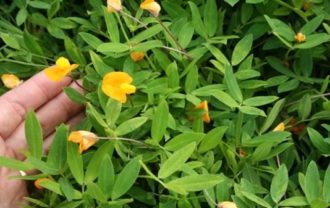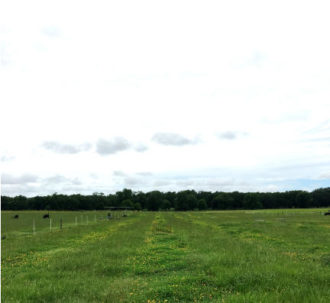MARIANNA, Florida – Perennial peanuts incorporated in forage grass production, such as bermudagrass and bahiagrass, continue to shine as nitrogen fertilizer alternatives to commercial inputs, according to University of Florida research.
Based on the results of a Southern Sustainable Agriculture Research & Education (SSARE) Graduate Student Grant, warm-season perennial legumes, in some cases, reduced nitrogen fertilization requirements while increasing overall nutritive value of the forage, thereby reducing input costs and increasing forage quality.
“Perennial warm-season legumes combined with perennial warm-season grasses is a potential system to explore for cattle production in the Southeast,” said Jose Dubeux, Jr., a forage management specialist with the University of Florida North Florida Research and Education Center (NFREC).
Rhizoma peanut (Arachis glabrata Benth.) is one of the few warm-season legumes available to producers that have proven successful in integrated forage production systems. In the SSARE study (GS14-129), “Potential Use of Seeded Peanuts as Warm-season Legumes in the U.S. Southern Coastal Plains,” two rhizome peanut cultivars (Ecoturf and Florigraze) increased production in unfertilized Tifton-85 bermudagrass trial plots – a case to be made that natural fertilizer can add value in production scenarios where no nitrogen is typically applied.
Producers, however, have been slow to adopt rhizoma peanut, said Dubeux. “There is a high cost associated with planting the legume and it’s slow to establish, as it is vegetatively propagated and typically requires two years for full establishment before producing significant returns.”
With this challenge in mind, Dubeux evaluated the performance of seeded perennial peanuts (pinto peanut and annual peanut) in bahiagrass and bermudagrass trials.
“Seed propagation and perennial persistence are two key traits that could allow Pinto peanut (Arachis pintoi) to be widely used in the Southern U.S.,” said Dubeux. “Annual peanut (Arachis hypogea) is planted widely in the Florida panhandle, so if proper grazing/harvesting management practices are used to allow the annual peanut to set pods to maturity, a seed bank might be created allowing the peanut to reseed the following growing season.”
Researchers did find success with using the legumes in the SSARE study. Annual peanut cultivar TUFrunner ‘727’ produced greater nitrogen concentrations in the bahiagrass and bermudagrass trials compared to the other peanuts in the study. And while commercially fertilized bahiagrass plots did produce higher yields, inclusion of the peanuts in the system provided higher quality forage. Rhizoma peanut cultivars, however, were still more productive than the seeded peanuts tested in this study.
Now that researchers have learned how to establish these integrated systems, Dubeux said the next step is to get livestock performance data into producers’ hands.
Published by the Southern Region of the Sustainable Agriculture Research and Education (SARE) program. Funded by the USDA National Institute of Food and Agriculture (NIFA), Southern SARE operates under cooperative agreements with the University of Georgia, Fort Valley State University, and the Kerr Center for Sustainable Agriculture to offer competitive grants to advance sustainable agriculture in America's Southern region. This material is based upon work that is supported by the National Institute of Food and Agriculture, U.S. Department of Agriculture, through Southern Sustainable Agriculture Research and Education, under sub-award number: GS14-129. USDA is an equal opportunity employer and service provider. Any opinions, findings, conclusions, or recommendations expressed in this publication are those of the author(s) and do not necessarily reflect the view of the U.S. Department of Agriculture.

